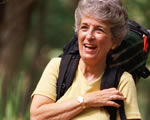 Go to main content
Go to main content
Archive Website of the UK government
Please note that this website has a UK government accesskeys system.
Main menu
Page menu
Environment and greener living

Keeping safe in the countryside

If you’re planning a trip in the countryside, particularly in a remote area, it makes sense to know how to keep yourself safe. From planning your route to carrying a fully-charged mobile phone, get safety tips and find out what you should do in an emergency.
Staying safe
A little forward planning can make all the difference:
- plan your route, making sure it is within your capabilities
- tell someone responsible where you are going and what time you expect to return (if possible give them a copy of your route)
- make sure you have the right clothing and equipment - always anticipate the worst conditions and always take waterproofs
- pack something extra to eat and drink along with your normal food and drink for the day
- carry a first aid kit
- carry a fully charged mobile phone and spare battery
- stick to established routes
If you plan to take long walks, hikes or bike rides regularly, you should think about learning some basic orienteering skills such as map-reading and using a compass.
In an emergency situation
The most important thing is to stay calm.
If you find yourself in an emergency situation or see others in difficulty, use your mobile phone to dial 999. You should ask for:
- the police, if you are in an area that is easily reached by car or on foot
- the coastguard, if you are on the coast (ie beaches, shoreline, cliff tops, cliff path)
- mountain rescue if you are in a hiking or climbing area
The person you speak to will ask for the following information:
- location of incident - you should spell out any place names and in a remote area it will help if you can supply a national grid reference
- nature of the emergency - describe what has happened, eg fallen cyclist, walker cut off by tide, and any injuries
- number of people involved/injured
For information on dealing with emergencies at sea or at the coast, read 'How to call for help in an emergency at sea'.
Using mobile phones in an emergency
Mobile phones can save lives in an emergency, but coverage may be variable and batteries can run low. These tips will help you get the most out of your phone when it matters:
- before you set off arrange to make calls at certain times or certain points in your journey, and switch off your phone between calls to save power
- fully charge all batteries before you set off
- keep your phone in a plastic bag somewhere warm but where you can still hear it - and keep a spare battery in a separate bag
- in areas with bad reception stand still with your phone once you have made a connection so you do not lose it mid-conversation
- if you are trapped or injured and can't move but don't have enough network coverage to make a call, try sending an SMS text message instead
- keep calls short to avoid wasting battery power
- if you are in contact with emergency services they may set up a schedule to call you every 20/30 minutes, in which case you can arrange to turn off your phone between calls
If you are in a group and your own service provider has no coverage from where you are:
- try other phones - one at time to save batteries (or swap batteries)
If none of the phones have network coverage:
- consider taking all the phones to a more prominent location if possible - but only if you can do so without getting lost
 Facebook
Facebook Twitter
Twitter StumbleUpon
StumbleUpon Delicious
Delicious Reddit
Reddit
